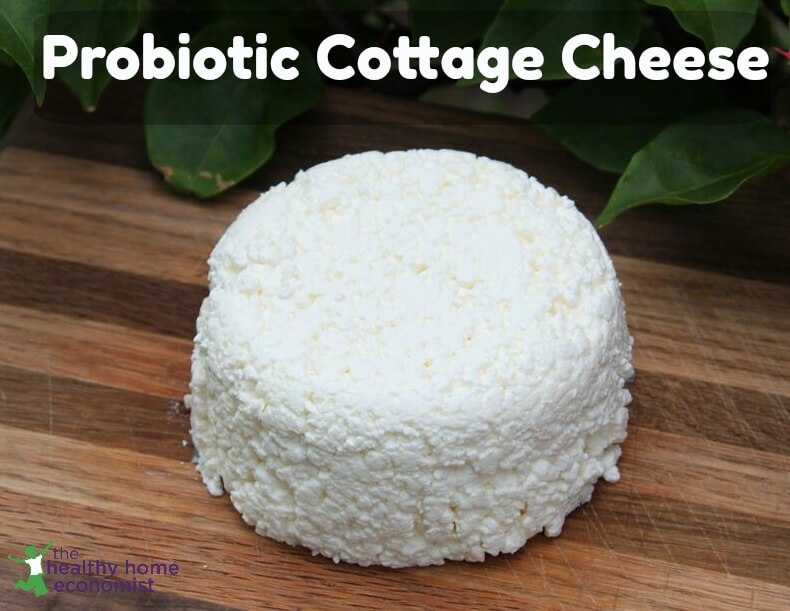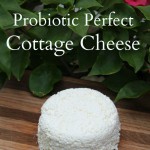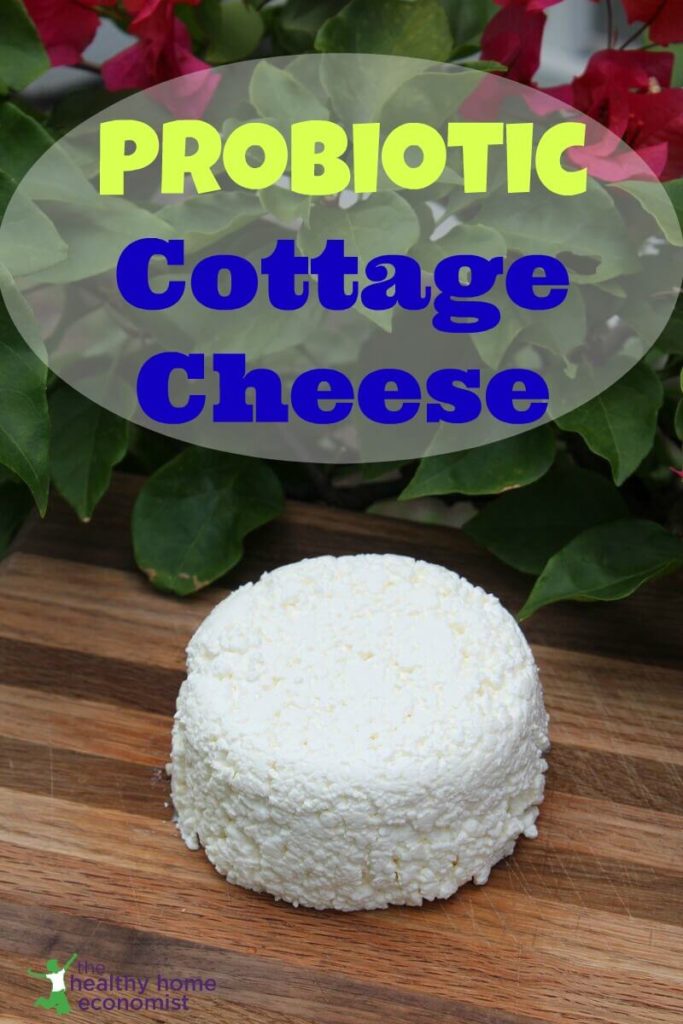Easy recipe for full fat cottage cheese with probiotics and enzymes intact which is virtually impossible to find at supermarkets or healthfood stores.

In the Western world, cottage cheese is nearly synonymous with dieting and all things related to the pursuit of skinny.
Cottage cheese is typically served with sliced fruit on top as an ultra low-calorie meal. It’s been the poster child for losing weight since the lowfat dogma of the 1960s took hold and escorted Westerners down a path to even greater weight and health challenges.
Unfortunately, the madness continues in conventional circles to this day. The American Heart Association recently blasted coconut oil as heart unhealthy. Seriously?
Why then did ancestral cultures that ate LOTS of it suffer virtually no heart disease? No wonder an increasing number of people don’t pay any attention and choose to do their own research.
While cottage cheese is certainly a nutritious, traditional food (Little Miss Muffet was probably eating something similar while sitting on her tuffet), it has, in the modern sense, seriously lost its way.
Supermarket and even organic health food store cottage cheese is highly processed and lowfat. Such concoctions are more likely to trigger binge eating than satisfy and proactively assist with sustainable weight loss goals.
This is because the skim milk from which the cottage cheese is made, organic or not, has had all the nutrient-dense cream removed. Worse, it has been pasteurized at high temperatures destroying much of the nutrition (Vitamins C and E, B12, B1, B2, folate). Digestive enzymes and beneficial microbes known as probiotics are obliterated as well.
And, as anyone who truly understands nutrition knows, skim milk and anything made with it encourages weight gain much more readily than helps you lose weight! Just ask any pastured pig farmer – skim milk is a key tool to get the pigs really fat!
Sourcing Truly Healthy Cottage Cheese
Finding probiotic and enzyme-rich, full fat cottage cheese is very difficult if not impossible depending on where you live. If you’re lucky enough to source locally, chances are it will be from a small grassfed dairy.
As a result, if you’re a cottage cheese lover like I am, it’s best to learn how to make it yourself. Fortunately, the process of making truly traditional cheese of the modern cottage variety is simple.
And, when you handcraft and consume curds and whey in this manner, it really will help you with your weight loss goals because, in a word, it will truly satisfy!
Probiotic, Enzyme Rich and Full Fat
The best recipe for full fat, raw cottage cheese (newsflash: the way it’s supposed to be) that I’ve seen is actually illustrated in The Nourishing Traditions Cookbook for Children.
That’s right, healthy cottage cheese is so simple to make a child can actually do it!
If you want to teach your children the basics of traditional cooking, this lovely little cookbook is a must-have. It’s spiral bound for easy page flipping by little hands and contains ingredient illustrations instead of hard to follow ingredient lists.
My daughter and I have been poring through it this summer to expand her culinary knowledge. I highly recommend it for anyone with children 10 and under.
Homemade Cottage Cheese
Many thanks to author Sally Fallon Morell for generously allowing the sharing of this recipe and ingredient illustration from The Nourishing Traditions Cookbook for Children.
Equipment Needed
The image below shows the equipment and ingredients you will need to get started making the homemade cottage cheese recipe.


Cottage Cheese Recipe
Easy recipe for full fat cottage cheese with probiotics and enzymes intact which is virtually impossible to find at supermarkets or healthfood stores.
Ingredients
Instructions
-
Pour the milk into a large mixing bowl (I use these glass bowls). Cover the bowl with a plate and leave it in the refrigerator until all the cream rises to the top. This might take up to 24 hours.
-
Skim off the cream with a spoon or easier still, a stainless steel turkey baster, and save it in a pint sized glass mason jar or similar container in the refrigerator (hint: you will use it later!).
-
Mix the kefir or yogurt into the milk with a spoon. Cover the bowl with a plate once more and leave on the counter at room temperature until the milk thickens like yogurt. This is what is called the curd and it will take 1-2 days depending on your home’s temperature and the freshness of the raw milk.
-
Using a knife, cut the curd in the bowl into tiny squares by slicing through it from top to bottom and left to right. Try to keep the cuts no larger than 1/4 – 1/2 inch (.64 cm – 1.3 cm) apart.
-
Fill a medium sized pot with filtered water about 1 inch deep. Put the pot on the stovetop with the burner set to low heat. Place the bowl of curds with the plate removed on top.
-
Test the temperature of the curds every 5 minutes with a digital food thermometer. After each 5 minute check, stir the curds for a few seconds. Continue with this process for about 30 minutes (6 – 5 minute checks) until the curds reach 110 F/43 C. All enzymes and probiotics will be preserved if you only heat to this low temperature. How to know? If you stick your finger in and don't get burned, no destruction of beneficial microbes or enzymes has occurred. This would happen if you heat the milk higher than 117 F/47 C, which is why it is so important to keep checking the cottage cheese every 5 minutes to ensure that the temperature doesn't get too high.
-
Remove the bowl from the heat when the desired temperature has been reached and separate the curds from the whey with a strainer set inside a mixing bowl. The curds will stay in the strainer and the liquid whey will run into the bowl underneath.
-
Rinse the curds still inside the strainer with cold, filtered water. Be sure to very gently stir the curds with a spoon until all the water drains out.
-
Put the curds in a container and mix with the sea salt and reserved cream you have in the refrigerator. You now have raw, full fat cottage cheese with all the beneficial probiotics, vitamins and enzymes from the raw milk still intact! Cottage cheese is delicious freshly made, but be sure to refrigerate any leftovers. In my experience, this truly traditional cottage cheese lasts for several weeks in the refrigerator.
Recipe Notes
Full fat yogurt may be substituted for the kefir. These yogurt brands are best.
More Information on Healthy Cheese
If learning to make cheese is exciting to you, check out my other cheesemaking posts here:









What is the reason for heating it up on the stove? Wouldn’t raw milk that has been left to sit out for a couple days just turn to curds and when itself?
Can you make this without the salt? The reason I ask is my dad loves cottage cheese but can’t have salt (he is a kidney patient ) so Im always on the hunt for no salt recipes or ones that if I leave out the salt won’t be all funky tasting. Thanks
I salt is important and should not be left out else the recipe may not “take”.
Hi there,
I’ve been making yogurt and cottage cheese forever, but I’m so glad I found this probiotic recipe! I think Nancy’s makes one, but that’s the only one we’ve seen around here. We were unable to get raw cows milk, and had just used our raw goats milk. I made this recipe using pasteurized (not UP) whole milk, and Brown Cow yogurt. It’s actually cold in southern ca. right now, so I wasn’t surprised that it hadn’t done anything by the next day, but it’s been almost two days now, and it IS bubbled on the top,but not thick enough to cut into cubes. Am I heading in the right direction? Thx!
Hi, Thank you for all of the interesting information that you have put on all of these pages about using raw milk to make all of these yummy things. I have a top shelf in my fridge full of raw sour goats milk. Can I use it to make cottage cheese and Kefir or do you have a better easier suggestion for me to be able to use it instead of throwing it down the drain. There are pages and pages of information about goats milk or raw milk in general and it is very overwhelming for me to even get started. I don’t want to get rid of this sour milk so this is why I just decided to write to you and see if you will have the time to write me back. I am very discouraged because I just cannot waste this milk and I do not know for sure what to do with it. Could you please help me. I know that you are very busy but I need your help somehow if you can find the time to do so. I would so appreciate it if you are able to . And Thank You so much for your time in reading this lengthly note.
Very SIncerely,
Barbara in Michigan
Yes, you can make cottage cheese and kefir from goat milk just the same as cow milk. Hope that helps 🙂
It seems like every time I make this recipe it comes out different. The first time on made it, it was awesome. Since then, something has always been off and I can’t figure out what I am doing differently. This time, my curds didn’t seem to form. It looks like I didn’t skim all of the cream off in the beginning and then it just thickened on the top of the milk. I’m not sure if I should go ahead and start heating the whole thing or skim it off.
What is the difference between long process cottage cheese and cream cheese? It seems to be the same?
Whoops! Well, that didn’t work so well — my glass bowl broke during the heating process, dumping glass and all my beautiful curds and whey into the pot below. I wondered about that when I put the bowl on top of the pot, and when it broke I thought, “well there’s my answer”. I’ll have to choose my bowl more carefully next time. **sigh**
Hi!:) Thanks for a great recipe. I cannot tolerate just plain milk or cream that has not been fermented for 24 hours. I see leaving the cream in the cottage cheese isn’t a good option, so what can I do to ensure that I have full fat cottage cheese and yet have the cream fermented 24 hours? Maybe I could just make crem fresche out of the cream and add it to the cottage cheese when its done?
Made the cheese! ???? Tastes different than store-bought, but I’m acquiring a taste for it! Question: what can I do with the whey I drained off? I hate to waste it as raw milk is not cheap!
Use it as starter to ferment something else … like sauerkraut or beet kvass!
Thanks for the quick reply! Will search your site for instructions for making these!
Wondering if I could make this right in the top of my double boiler pot, which is stainless steel? That way I wouldn’t have to transfer when it came time to heat it on the stove ….or could I start in the glass bowl, and transfer to the steel pot for the heating process?